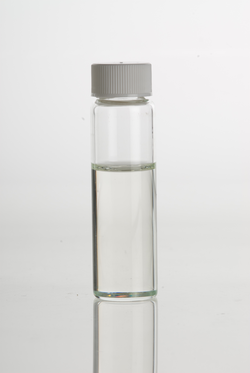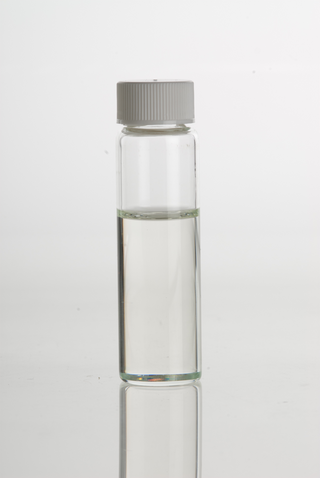Pine oil
Chemical compound From Wikipedia, the free encyclopedia
Pine oil is an essential oil obtained from a variety of species of pine, particularly Pinus sylvestris. Typically, parts of the trees that are not used for lumber — stumps, etc. — are ground and subjected to steam distillation.[2] As of 1995, synthetic pine oil was the "biggest single turpentine derivative."[3] Synthetic pine oils accounted for 90% of sales as of 2000.[4]
 Pine (Pinus sylvestris) essential oil in a clear glass vial | |
| Names | |
|---|---|
| Other names
Essential oil of pine Yarmor | |
| Identifiers | |
| 8191505 | |
| ChemSpider |
|
| ECHA InfoCard | 100.219.894 |
| UNII | |
CompTox Dashboard (EPA) |
|
| Properties | |
| Mixture | |
| Appearance | Colorless to pale yellow liquid |
| Density | 0.875 g/cm3 at 25 °C (approximate) |
| Melting point | 5 °C (41 °F; 278 K) |
| Boiling point | 195 °C (383 °F; 468 K) |
| Insoluble | |
| log P | 1.7 |
| Vapor pressure | 4 mmHg |
| Hazards | |
| NFPA 704 (fire diamond) | |
| Flash point | 65 °C (149 °F; 338 K) |
Except where otherwise noted, data are given for materials in their standard state (at 25 °C [77 °F], 100 kPa).
| |
Composition
Pine oil is a higher boiling fraction from turpentine. Both synthetic and natural pine oil consists mainly of α-terpineol, a C10 alcohol (b.p. 214–217 °C).[5][1] Other components include dipentene and pinene.[6] The detailed composition of natural pine oil depends on many factors, such as the species of the host plant.[7] Synthetic pine oil is obtained by treating pinene with water in the presence of a catalytic amount of sulfuric acid. This treatment results in hydration of the alkene and rearrangement of the pinene skeleton, yielding terpineols.[4]
Uses
Summarize
Perspective
Industrially, pine oil was once used in froth flotation for the separation of mineral from ores.[1] For example, in copper extraction, pine oil is used to condition copper sulfide ores for froth flotation.
It is also used as a lubricant in small and expensive clockwork instruments.
In alternative medicine it is used in aromatherapy and as a scent in bath oils.
Properties as a disinfectant
Pine oil is used as a cleaning product, disinfectant, sanitizer, microbicide (or microbistat), virucide or insecticide.[5] It is an effective herbicide where its action is to modify the waxy cuticle of plants, resulting in desiccation.[8] Pine oil is a disinfectant that is mildly antiseptic.[9] It is effective against Brevibacterium ammoniagenes, the fungi Candida albicans, Enterobacter aerogenes, Escherichia coli, Gram-negative enteric bacteria, household germs, Gram-negative household germs such as those causing salmonellosis, herpes simplex types 1 and 2, influenza type A, influenza virus type A/Brazil, influenza virus type A2/Japan, intestinal bacteria, Klebsiella pneumoniae, odor-causing bacteria, mold, mildew, Pseudomonas aeruginosa, Salmonella choleraesuis, Salmonella typhi, Salmonella typhosa, Serratia marcescens, Shigella sonnei, Staphylococcus aureus, Streptococcus faecalis, Streptococcus pyogenes, and Trichophyton mentagrophytes.[5]
Safety
With respect to the quality of indoor air, attention is directed to the effects of ambient ozone on pine oil components.[10] Large doses may cause central nervous system depression.[1]
See also
- List of cleaning products
- Dettol antiseptic liquid
- Pine-Sol, cleaning product that originally contained pine oil, though it switched to a different active ingredient in 2013 due to the declining availability of pine oil
References
Further reading
Wikiwand - on
Seamless Wikipedia browsing. On steroids.

